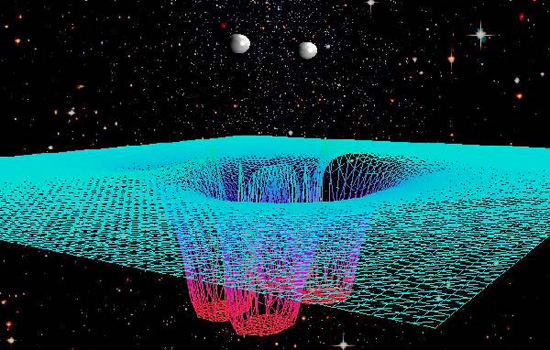RIT scientists featured in APS's nod to Einstein
Their landmark paper is included in curated collection
Campanelli et al, Visualization: Hans-Peter Bischof
This simulation of binary black holes illustrates the moment before the masses merge. The impact produces gravitational waves described in a 2006 landmark paper by Manuela Campanelli, Carlos Lousto, Yosef Zlochower and Pedro Marronetti.
Scientists at Rochester Institute of Technology have been recognized by the American Physical Society for their breakthrough research and contributions to the field of general relativity.
The society’s “2015—General Relativity’s Centennial” website is a collection of seminal papers celebrating 100 years of Einstein’s theory of general relativity in November highlights research conducted by Manuela Campanelli, Carlos Lousto and Yosef Zlochower, professors in RIT’s School of Mathematical Sciences and the founding members of the Center for Computational Relativity and Gravitation, and Pedro Marronetti, a researcher at the National Science Foundation. The curated papers begin with Einstein and include J.R. Oppenheimer and Stephen Hawking, among others.
The RIT team’s landmark paper and algorithm, “Accurate Evolutions of Orbiting Black-Hole Binaries without Excision,” was published in Physical Review Letters on March 22, 2006, Their method, dubbed “Moving Punctures,” solved the interrelated equations for strong field gravity that comprise Einstein’s theory of general relativity, connecting matter, space and time and simulated, for the first time, the merger of two orbiting black holes on a supercomputer.
This changed the landscape of the field of numerical relativity, and opened new frontiers in gravitational wave astrophysics, Campanelli said. The moving puncture approach led the RIT group to produce the first calculations of gravitational radiation from merging black holes with arbitrary masses and spins, the discovery of large gravitational-radiation recoils from merging spinning supermassive black-holes, the study of spin dynamics effects, such as spin-flips, precession and hang-up orbits and extreme mass-ratio binaries.
The collision replicated gravitational wave signatures and were early blueprints for the detection of actual gravitational waves using the Laser Interferometer Gravitational Wave Observatory. The LIGO Scientific Collaboration anticipates the first gravitational wave detection within the decade.
Campanelli and Lousto are members of the LIGO Scientific Collaboration and fellows of the American Astrophysical Society. Their research continues to explore extreme black holes.
“We do science because we want to answer some fundamental questions, in my case, it’s about gravitation and how it works in the universe,” Campanelli said. “But there is a whole series of other potential applications that come up when you advance knowledge in one direction. And sometimes it’s unexpected. You have to invent new tools, new mathematics.”













